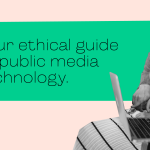
Nexo Jornal
Interview with Renatta Rizzi and Ibrahim Souza
February 2020
Founded in 2015, Nexo Jornal is a digital-first member-based independent news organization based in São Paulo, Brazil. Its content is multidisciplinary, combining longform investigative reporting, infographics, videos, a dedicated area to academic research, opinion pieces, quizzes and newsletters. Renatta Rizzi is their Cofounder and Director of Strategy and Business. Ibrahim Souza is their Technology Editor.
What’s the single most important issue facing Nexo Jornal right now?
Technology-wise, in the short term, it’s streamlining our user management and points of contact, and how to segment different kinds of engagement in different channels. Our ‘user model’ is fragmented in different platforms.
Publication-wise, I think it’s scaling our reach. For this, the technology team is working on different kinds of promotions, mechanics and tools to give more options to our marketing and sales teams.
In the long run, I think a lot about this ‘post cookie world’. Since we have a soft metered paywall, this is vital for us to think about. So I’m always studying new ways to identify users.
And I might add that our team is obsessed with performance. We strive for a faster, smaller and performant site. So our issue is to keep up to date with the latest in performance, while still making sure we’re paying attention to accessibility.
What are the real issues for you in the post cookie world? What are the particular issues for you around the shifts in browser technologies?
Today we were discussing Safari and Intelligent Tracking Prevention (ATP). It’s blocking some of our first party cookies and we don’t understand why. They’re from a sub domain, but a sub domain of Nexo. Maybe IP? I don’t know. The opacity of how Apple makes these kinds of decisions makes it hard for us to properly address the issue. It’s frustrating because a lot of people use Apple products. But we’re really in the dark on this issue.
And my next point is Google – they preach a lot about performance but inject a lot of JavaScript that is blocking our own user experience. It’s mind blowing. Another issue is that Google’s enforcing a new cookie policy in April 2020 I think, but Google itself is failing to meet this. It’s very strange. The cookie environment is very strange right now.
Do you have a clear technology strategy and a decision-making framework that you use?
We call our technology strategy ‘Data Driven Development’. I recently wrote a post about it on my blog here for those of you who speak Brazilian Portuguese – https://ibrahimcesar.dev/ddd/. Basically we gather as much data as possible, but with a key highlight for User Centric Metrics, and then devise strategies based on this data. By ‘User Centric Metrics’ we mean analyzing field data from users like ‘Largest Meaningful Paint’, ‘Time to first byte’, ‘Largest Contentful Paint’, and custom performance indicators with User Timing API that provides us with a better understanding of how our app interacts with users.
We try as much as possible to have an ‘and’ approach instead of an ‘or’ approach.
Our decision-making is informed by ideas around Progressive Enhancement and Adaptive Loading. So during development, we scope all the limitations that a new feature will have, and its impact on different types of networks, CPU, and browser capabilities. We try as much as possible to have an ‘and’ approach instead of an ‘or’ approach.
Unfortunately, we don’t invest a lot of time on documenting our finds, and share little with other teams, though we’re starting to do this more now in small groups. We recently discussed the idea of starting to use ‘Architecture Decision Records’.
Our challenges are often around how we look and behave; some teams are very visually driven, so in order to speed up the prototype phase (sometimes skipped entirely for deadlines) we are working on developing a design system for Nexo for better product management. This will help us avoid inconsistencies and improve our internal decision-making. We’re also trying to resolve the fact that much of the time we work on ad hoc solutions, which means our projects develop without full scoping or change a lot in the process, leaving little room to plan well. I’m going to try the responsibility assignment matrix when working with other teams.
Your tech strategy is very iterative, progressive and agile. Has this changed the way your editorial and technical teams talk together about what you need from your products? And how editorial is supported by tech and the other way around?
I think the short answer is yes, but it’s more complicated than that. Our tech coaching is agile from the start, but a lot of our editorial team comes from print. Sometimes we have these huge projects about elections, and we try to develop all the things they want in the time needed. Some projects work really well, but we have a lot of friction. The editor of the project team tends to think in lots of moving parts with stories being created on the fly. I know it’s needed as some news is emerging, but unfortunately we in tech can’t run as fast as is sometimes needed. But I should say sometimes this really works. We call longer reads ‘specials’ here, with a lot of interactives and different experiences in browsing and things like this. We can put together a team with developers and journalists and it works really well. The problem is that last year because we built our front end entirely, we did almost zero projects like that.
What was the last major tech decision you made and tell us why you made it?
We face a lot of decisions, but I think the biggest was choosing to migrate the underlying stack of the site, plus four years worth of content. There were several reasons to do so:
- CMS evolution: Our CMS, Escenic, was feeling old. Our editor was a java application running on machines, and any major changes implied a new deployment in a monolithic Java application. When they presented CUE, their evolution to a Headless CMS, the freedom of development was so much better.
- Multiplatform: Since it was a monolithic application, we didn’t have a friendly way to manipulate our content, demanding a lot of time with Java APIs to get a simple custom RSS feed working. In the migration, we had much better control of how to display our content.
- React: We wanted a way to create experiences in a fast and declarative way, and the component approach of React was a very strong selling point. The fact that The New York Times and other players moved to React solidified our decision, and in the process our team increased productivity, which I credit React for a lot since the developer doesn’t necessarily need to programme ‘in a framework’. It’s Javascript. Way simpler.
- Isomorphic application: Because we were working on a Javascript client-side application that uses Javascript in the server, it made sense to use Node.js because it’s the same language, knowledge is easily shared, and there’s a lot more consistency. And we had more than three years experience managing and building node apps.
- Server-side rendering: Because, being a newspaper, SEO is a top requirement, in order to rank better we wanted to have server-side rendering. Also, this makes the site much faster.
What’s a software decision or product you made or used that you wish you hadn’t and why?
Clojure as a language for the core platform for our Access Control. We chose Clojure because Access Control was built with the previous Escenic version and was meant to run alongside the same server. So being a webapp to run on tomcat was a ‘common sense’ decision. It runs in the JVM and it was the language of choice for a third party that worked with us. But I don’t think we properly understood how difficult it would be to manage an application in another language. Our tech team is made of generalists not specialists and Clojure is a niche language here in Brazil at the moment, and we can’t afford a specialist to manage this specifically given all the other initiatives we have. Another problem was there was little opportunity, if any opportunity at all, to share with our stack. We can’t share resources, libraries or even knowledge from app to app, like we do with Node.js apps.
Could you give us an idea of the major issues your tech strategy covers and what’s key for you in the next 12 months?
Access Control expansion: to provide a better ‘user model’, with support for new use cases and new possibilities. A new front page, the most visited page of our publication, which means a new editorial approach, new ways to manage the home page, and an effort for the whole team. It is an electoral year in Brazil, so our team will face the challenge of coverage alongside the editorial team. We’ll also launch two new publications this year so we need to create better internal tools, and always be improving and expanding the product.
And the next couple of years?
One concern I have is the proper administration of our cloud infrastructure. In one way we are agile and emerging and we can move fast. But in another way we can make a lot of decisions that in the longer run could be costly.
I think we’ll be expanding our current paywall because we’re in the post cookie environment right now, and we want to create more meaningful experiences for our readers. There are lots of ways we can innovate. One concern I have is the proper administration of our cloud infrastructure. In one way we are agile and emerging and we can move fast. But in another way we can make a lot of decisions that in the longer run could be costly. For example, let’s put another server on our infrastructure, great for three months, but then four months later we’re having to spend more time making things work with the new server. Or, ‘oh Microsoft is offering us a 20% discount on how we can better migrate all files’. I’ve never worked with a company for more than a couple of years, so now I’m thinking years into the future, for more long-term checking. When I joined Nexo, I couldn’t find any information anywhere about how you prepare a media company in the tech space. I think the New York Times is doing a really really great job. I’m really inspired by the NYT Open Team who publish on Medium. But there isn’t much else.
For entrepreneurs it’s really normal that there’s no tech person in the group of people starting up a news organization, which was our case too. We didn’t even know what a CMS was and we were very lucky to meet Ibrahim. I was sending out information to people who were also starting up news organizations asking if they’ve built a CMS, if they have a contract. It’s really difficult.
Tell us about the dominating tech platforms and what they mean to you. How do you feel about using them?
With Amazon, they mean a lot to us. Our whole architecture is built on AWS technologies. A move from AWS would cost us time and money.
With Apple, they impact us in the way we interact with their hardware/software, and distribution for podcasts. The first one is where we face more challenges. Sometimes we have issues and problems in OS versions of Apple products that are really specific, and the debug is costly, so we spend a lot of time trying to virtualize and reproduce the errors to work on it.
Google’s the gatekeeper of distribution. We use it for Analytics and Tag Management. There are internal discussions to add a ‘login with Google’, ‘subscribe with Google’, ‘AMP’ and others, but nothing is in development. In terms of ‘culture’ we are really followers of their engineering: Lighthouse, as an example, is our guide for development. Every page is measured against it. Because of partnerships we also have some tags from Google that injects 20+ cookies into several services, which I feel is too much. Our videos are hosted and distributed via YouTube. Chrome is our main browser. I like their approach to performance and ‘good tech’. Out of all the big five, Google is the one I most identify with in terms of their culture and vision of technology.
Microsoft created VS Code, our development editor of choice. And now, with the launch of Edge using Chromium, I think this will help a lot with web standards and help us provide a better experience. I used to have strong feelings against Microsoft but they changed how I view them.
We use Facebook’s Pixel for marketing and Instant Article purposes. It’s basically a distribution channel. We have a group for subscribers only.
How have you found Instant Articles as a distribution platform?
It’s kind of strange that a multi-billion dollar company has analytics that don’t work, with a lot of bugs.
I think it’s a mixed bag. Right now we are still paying thousands in ads and did not have any conclusive data. We also used Instant Articles with Facebook Subscriptions and we found out that there is a lot of noise in the data, that the Facebook team here in Brazil was not able to instruct our marketing team in a better way to read the data. We prioritized the call to the Facebook Pixel, meaning that when a user subscribed in our checkout, the pixel was loaded before our own register, and even following this way, our conversions in Facebook dashboard did not reflect our actual conversion numbers. It was related to us, that the data doesn’t correlate. It’s kind of strange that a multi-billion dollar company has analytics that don’t work, with a lot of bugs. I think the strategy to move fast is reflected in this ‘beta’ program, and honestly, that’s ok for me with a background in agile methodologies. But this is misaligned with their ‘business talk’ and their PR. They sell a thing they do not actually have, and leave companies, and their teams of data, marketing, sales and development people scratching their heads and allocating a lot of time and resources on it.
Have you become more critical or skeptical of relying on these technologies for distribution and audience building? Where are you on the decision about whether you really want to rely on those services for some of your core site features?
It’s a difficult question because in the same way we have a lot of problems with them, we rely on them for distribution and a lot of other projects. They fund efforts in development such as video production, they help us with information in PWA Technologies, they push subscribers with Google. I think the technical team is very critical, but at the same time we have to face the reality that they’re a gateway to the public.
Have you ever deliberately chosen an alternative to the ‘big five’ and how was it?
Not as an alternative entirely, but I always make the case to not ‘go full’ on certain strategies. Once, as an example, we talked about why we have logins in our system as opposed to relying on third parties like Facebook and Google. For me, it’s clear. We don’t want a lock-in or to ever rely on one provider only for our core business. The alternatives to distribution channels would be to create new spaces for collaboration and not depend on any one tool (Facebook groups, etc). But I don’t know if the tech investment would be returned since it would be so much effort to do something. The success would depend much more on creating meaningful connections, and I don’t know if the right incentives would be aligned to our publication. It’s an open question for me.

Renatta Rizzi
Cofounder and Director of Strategy and Business at Nexo Jornal

Ibrahim Souza
Technology Editor at Nexo Jornal

